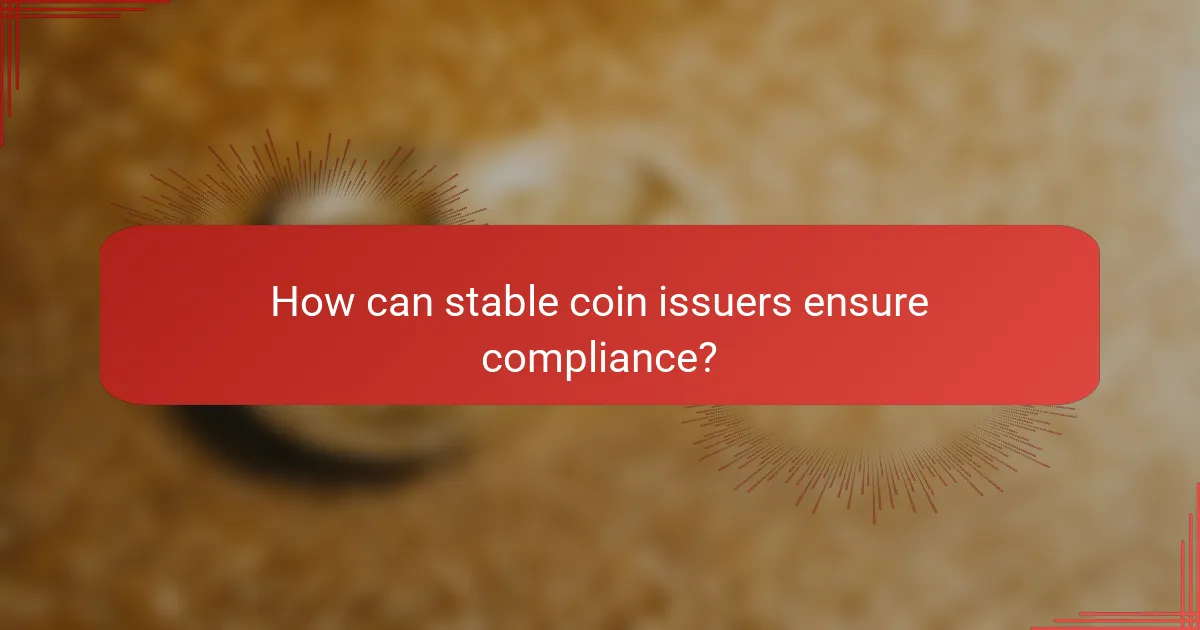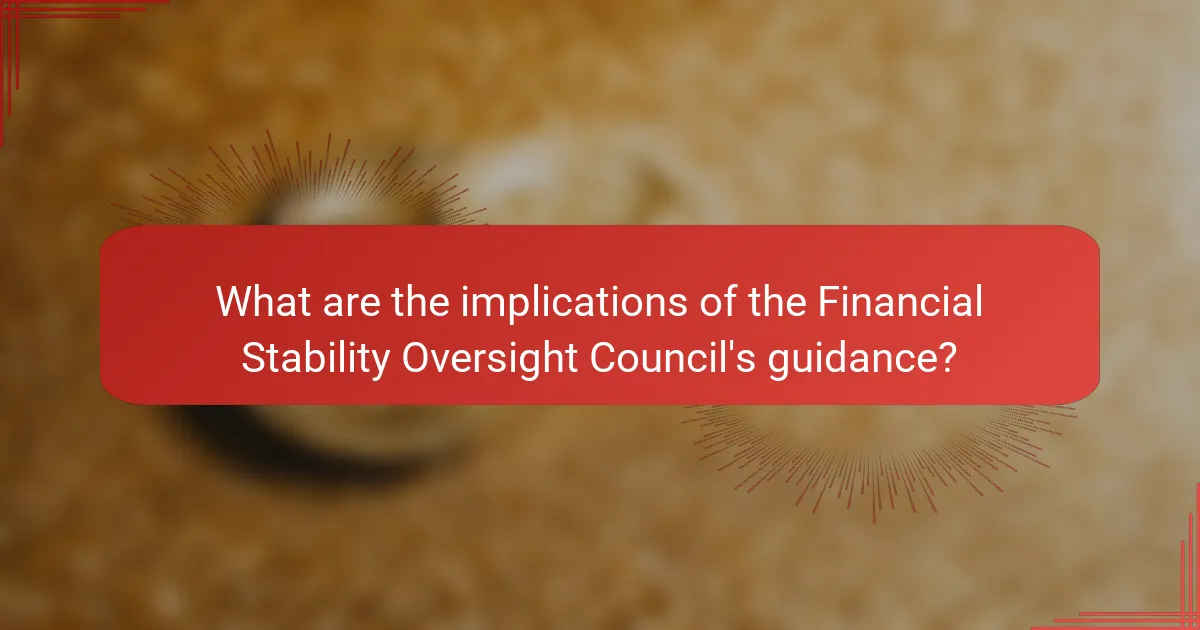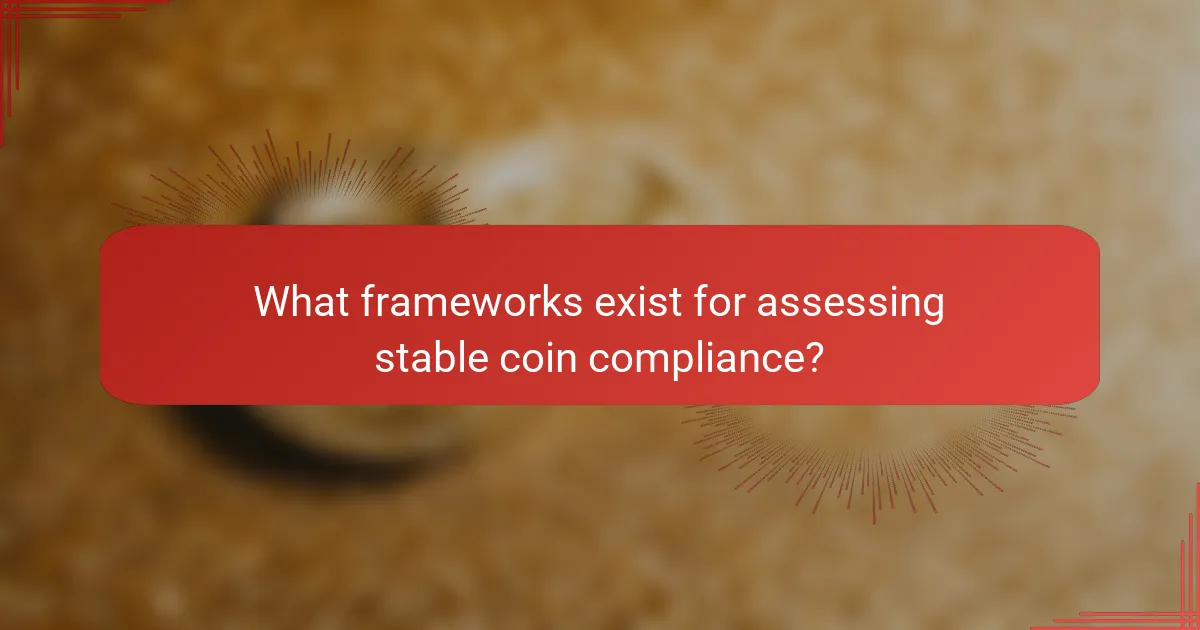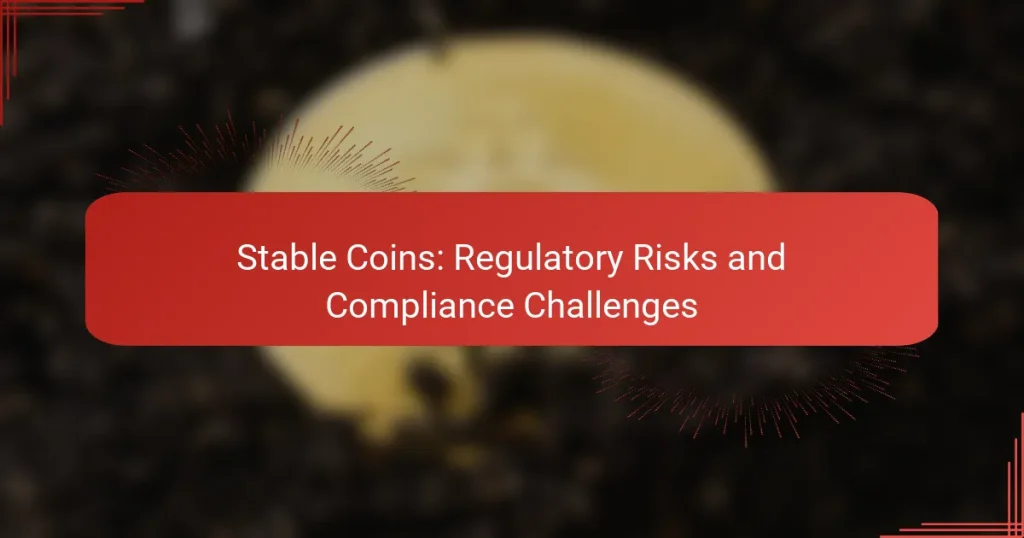Stable coins have emerged as a significant player in the financial landscape, but they come with regulatory risks that stem from their classification and compliance with existing financial regulations. As their popularity grows, regulators are intensifying scrutiny to safeguard consumer protection and ensure market stability. To navigate these challenges, stable coin issuers must adopt comprehensive regulatory frameworks, including Know Your Customer (KYC) procedures and regular audits, while engaging proactively with regulatory bodies.

What are the regulatory risks of stable coins in the US?
The regulatory risks of stable coins in the US primarily revolve around their classification, compliance with existing financial regulations, and potential market volatility. As stable coins gain popularity, regulators are increasingly scrutinizing their operations to ensure consumer protection and financial stability.
Market volatility impacts
Despite being designed to maintain a stable value, stable coins can still be affected by market volatility. Factors such as sudden changes in demand or regulatory announcements can lead to fluctuations in their value, potentially undermining user trust. For example, if a stable coin is pegged to the US dollar but experiences significant sell-offs, it may temporarily lose its peg.
Investors should be aware of these risks and consider the underlying assets backing the stable coin. Coins backed by a mix of fiat and cryptocurrencies may exhibit different volatility characteristics compared to those fully backed by fiat currency.
Legal classification issues
Stable coins face legal classification challenges, as regulators must determine whether they are securities, commodities, or currencies. This classification affects how they are regulated and the compliance requirements they must meet. For instance, if classified as securities, issuers may need to register with the SEC and adhere to strict disclosure requirements.
Understanding the legal landscape is crucial for stable coin issuers and users alike. Engaging with legal experts can help navigate these complexities and ensure compliance with applicable laws.
Compliance with SEC regulations
Compliance with SEC regulations is a significant concern for stable coin issuers in the US. The SEC has indicated that some stable coins may fall under its jurisdiction, particularly if they are deemed to be securities. This means that issuers must be prepared to comply with registration and reporting obligations.
To mitigate compliance risks, stable coin issuers should implement robust governance frameworks and maintain transparency with users. Regular audits and clear communication about the coin’s backing assets can help build trust and ensure adherence to regulatory standards.

How can stable coin issuers ensure compliance?
Stable coin issuers can ensure compliance by implementing robust regulatory frameworks that include Know Your Customer (KYC) procedures, regular audits, and proactive engagement with regulatory bodies. These measures help mitigate risks and align operations with legal requirements.
Implementing KYC procedures
Implementing KYC procedures is essential for stable coin issuers to verify the identities of their users. This process typically involves collecting personal information such as names, addresses, and identification documents. By doing so, issuers can prevent fraud and comply with anti-money laundering (AML) regulations.
Issuers should establish a clear KYC policy that outlines the steps for customer verification, including risk assessment and ongoing monitoring. Utilizing technology such as biometric verification or blockchain-based identity solutions can streamline this process and enhance security.
Regular audits and reporting
Regular audits and reporting are crucial for maintaining transparency and accountability in stable coin operations. Issuers should conduct internal and external audits to assess compliance with financial regulations and operational standards. These audits help identify potential risks and areas for improvement.
Additionally, stable coin issuers should provide regular reports to stakeholders, including financial statements and compliance updates. This practice not only builds trust with users but also ensures adherence to regulatory requirements, which may vary by jurisdiction.
Engaging with regulatory bodies
Engaging with regulatory bodies is a proactive approach for stable coin issuers to stay informed about evolving regulations and compliance expectations. By maintaining open lines of communication, issuers can better understand regulatory frameworks and adapt their practices accordingly.
Issuers should consider participating in industry forums or working groups that focus on regulatory issues. This involvement can provide valuable insights and help shape future regulations, ensuring that the stable coin ecosystem operates within a compliant and secure environment.

What are the implications of the Financial Stability Oversight Council’s guidance?
The Financial Stability Oversight Council’s guidance on stable coins emphasizes the need for enhanced regulatory oversight to mitigate risks associated with their use. This guidance aims to ensure that stable coin issuers maintain adequate reserves and comply with financial stability standards.
Increased scrutiny on stable coin reserves
With the new guidance, stable coin reserves will face heightened scrutiny from regulators. Issuers must provide clear evidence of their asset backing, ensuring that reserves are sufficient and liquid enough to meet redemption demands. This may involve regular audits and transparency reports to build trust with users and regulators alike.
For example, if a stable coin is pegged to the US dollar, the issuer must hold an equivalent amount in cash or cash-equivalents, which could include government bonds or other safe assets. Failure to maintain these reserves could lead to regulatory penalties or loss of operational licenses.
Potential for stricter capital requirements
The guidance may lead to stricter capital requirements for stable coin issuers, compelling them to hold more capital against potential risks. This could result in higher operational costs, which may be passed on to users through fees or reduced yields on stable coin holdings.
Issuers might need to maintain a capital buffer that is a certain percentage of their total liabilities, similar to traditional banks. This could range from 5% to 15%, depending on the regulatory framework adopted by the authorities.
Impact on market participants
The implications of the Financial Stability Oversight Council’s guidance will significantly affect market participants, including investors, issuers, and exchanges. Increased compliance costs may lead some smaller issuers to exit the market, reducing competition and potentially leading to higher prices for consumers.
Additionally, investors may experience changes in the risk profile of stable coins, as stricter regulations could enhance stability but also limit innovation. Market participants should stay informed about regulatory developments to adapt their strategies accordingly and ensure compliance with evolving standards.

How do international regulations affect US stable coins?
International regulations significantly influence US stable coins by shaping compliance requirements and operational frameworks. As stable coins are often used globally, adherence to varying international standards is crucial for their acceptance and functionality.
Comparison with EU regulations
The European Union has established a comprehensive regulatory framework for stable coins, notably through the Markets in Crypto-Assets (MiCA) regulation. This framework emphasizes consumer protection, market integrity, and financial stability, which contrasts with the more fragmented regulatory landscape in the US.
In the EU, stable coin issuers must meet stringent capital requirements and undergo regular audits, whereas US regulations are still evolving. This difference can create challenges for US-based stable coin projects seeking to operate in European markets.
Global compliance challenges
Global compliance challenges arise from the lack of uniformity in regulations across jurisdictions. Stable coin issuers must navigate diverse legal landscapes, which can lead to increased operational costs and complexity. For example, a stable coin compliant in the US may not meet the requirements in Asia or Africa.
Additionally, varying definitions of what constitutes a stable coin can complicate compliance efforts. Issuers must stay informed about international regulatory developments to avoid penalties and ensure market access.
Cross-border transaction risks
Cross-border transactions involving stable coins carry risks related to regulatory compliance and currency fluctuations. Different countries may impose restrictions on the use of stable coins, affecting their liquidity and usability in international trade.
Moreover, the potential for regulatory crackdowns in certain jurisdictions can lead to sudden changes in the legal status of stable coins, impacting their value and acceptance. Issuers should implement robust risk management strategies to mitigate these cross-border challenges.

What frameworks exist for assessing stable coin compliance?
Several frameworks are available for assessing stable coin compliance, focusing on regulatory adherence, risk management, and operational integrity. These frameworks help organizations navigate the complex landscape of regulations and ensure that their stable coin offerings meet legal requirements.
Risk assessment matrices
Risk assessment matrices provide a structured approach to identify and evaluate potential risks associated with stable coins. These matrices typically categorize risks based on their likelihood and impact, allowing organizations to prioritize their compliance efforts effectively.
For example, a matrix might classify risks into categories such as operational, market, and regulatory risks, helping teams focus on the most critical areas. Regularly updating these matrices is essential to address evolving regulatory landscapes and market conditions.
Best practice guidelines
Best practice guidelines offer a set of recommendations for stable coin issuers to ensure compliance and mitigate risks. These guidelines often cover areas such as transparency, consumer protection, and anti-money laundering (AML) measures.
Organizations should adopt these practices by implementing robust Know Your Customer (KYC) protocols and maintaining clear communication with users about the risks associated with stable coins. Following these guidelines can enhance credibility and trust among users and regulators.
Industry standards and certifications
Industry standards and certifications play a crucial role in establishing credibility for stable coins. Various organizations, such as the International Organization for Standardization (ISO), provide frameworks that help companies demonstrate compliance with best practices and regulatory requirements.
Obtaining relevant certifications can signal to regulators and users that a stable coin adheres to recognized standards, potentially easing compliance challenges. Companies should consider pursuing certifications that align with their operational goals and regulatory obligations to enhance their market position.

What are the emerging trends in stable coin regulation?
Emerging trends in stable coin regulation focus on enhancing oversight and ensuring compliance with financial standards. As stable coins gain popularity, regulators are increasingly addressing issues related to transparency, consumer protection, and systemic risk.
Increased collaboration among regulators
Regulatory bodies across various jurisdictions are beginning to collaborate more closely on stable coin frameworks. This cooperation aims to create a cohesive approach to regulation that can effectively manage the cross-border nature of digital currencies.
For example, organizations like the Financial Stability Board (FSB) are working with national regulators to establish guidelines that promote consistency in regulatory practices. This collaboration helps mitigate risks associated with regulatory arbitrage, where companies might exploit differences in regulations between countries.
Adoption of blockchain transparency measures
As part of regulatory efforts, there is a growing emphasis on implementing transparency measures within blockchain technology. These measures can include requirements for issuers to provide regular audits and disclosures about their reserves and operations.
For instance, some jurisdictions are considering mandates for stable coin issuers to publish real-time data on their backing assets. This transparency not only builds trust among users but also allows regulators to monitor compliance and assess potential risks more effectively.


